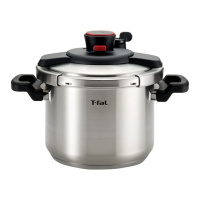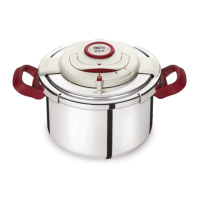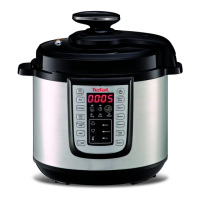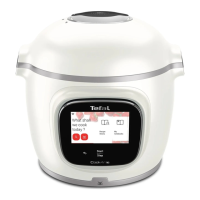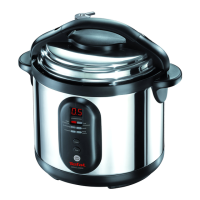AFTER
COOKING
Gradually turn the operating valve (A) to adjust the pressure
release speed, until it aligns with the symbol
- fig 9. If, when
releasing steam, you notice any food or liquid starts to spurt out,
return the operating valve (A) to the position, then carry out
rapid pressure release by standing the pressure cooker in a sink
half filled with cold water - (refer to the “End of cooking section.).
If the pressure indicator (D) does not go down, carry out rapid
pressure release a sink half filled with in cold water - (refer to the
“End of cooking section).
Never interfere with the pressure indicator.
For foodstus that expand and/or foam during cooking, such
as rice, pulses, dehydrated vegetables, stewed fruit, pumpkin,
courgettes, carrots, potatoes, fillets of fish, etc. Let your pressure
cooker cool down for a few minutes, and then carry out rapid
pressure release in cold water - (refer to the section ‘End of
cooking). Always gently shake the pressure cooker each time
before opening, after having checked that the pressure indicator
has gone down to the lowered position, to prevent bubbles of
steam from overflowing and burning you. This operation is
particularly important when steam is released quickly or after
cooling down the pressure cooker under tap water.
Always be very careful when moving your pressure cooker
under pressure. Do not touch hot surfaces. Use oven mitts when
necessary. Lift using both of the handles.
For soups, we recommend that you do a rapid pressure release
in cold water (refer to the “End of cooking” section).
Make sure the operating valve (A) is in the steam release
position before opening the pressure cooker. The pressure
indicator (D) should be in the lowered position.
Never use force to open your pressure cooker. Make sure the
internal pressure has been released. The pressure indicator (D)
should be in the lowered position. (See “Safety” section).
RETAIN THESE INSTRUCTIONS
CLEANING AND
MAINTENANCE
If you notice that any part of your pressure cooker is
broken or cracked, do not attempt to open it under
any circumstances. Wait for it to cool down completely
before moving it. Do not use it again and take it to a
TEFAL Approved Service Centre for repair.
Do not tamper with the safety systems other than when
following the cleaning and maintenance instructions.
Only use the genuine TEFAL parts that correspond to
your model.
Do not leave food in the pressure cooker.
Wash and rinse your pressure cooker immediately after
each use.
Never put the operating valve (A), the gasket (I), the
cook control* (G (d)), in the dishwasher.
Never place the timer* (G (d)) in water.
Never use bleach or chlorine-based products, which could
aect the quality of the stainless steel.
Do not let the lid soak in water.
Change the gasket every year, or immediately if it is split
or shows signs of cracking..
Make sure you get your pressure cooker at a TEFAL
Approved Service Centre after 10 years of use.
To store your pressure cooker: rest the lid upside down
on the pan, to avoid premature wear of the lid’s gasket.
The appearance of white spots in the bottom of the pot
does not aect the quality of the metal at all. These are
limescale deposits. To remove them, use a sponge with
a little white vinegar.
* Depending on model.
52
51
EN
